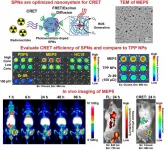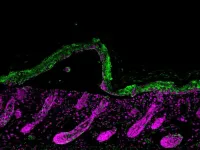(Press-News.org) Summer picnics and barbecues are only a few weeks away! As excited as you are to indulge this summer, Escherichia coli bacteria are eager to feast on the all-you-can-eat buffet they are about to experience in your gut.
However, something unexpected will occur as E. coli cells end their journey through your digestive tract. Without warning, they will find themselves swimming in your toilet bowl, clinging to the last bits of nutrients attached to their bodies. How do these tiny organisms adapt to survive sudden starvation? Scientists at Washington University in St. Louis wondered.
Close examination of nutrient-deprived E. coli under the microscope -- a routine process in a lab that studies bacterial cell size -- revealed cells that looked different, and that these differences are related to their ability to survive.
"Their cytoplasm shrank. As it shrank, the inner membrane pulled away from the outer membrane and left a big space at one end of the cell," said Petra Levin, professor of biology in Arts & Sciences, whose postdoctoral scientist, Corey Westfall, and undergraduate student, Jesse Kao, first made the observation.
The space to which Levin refers, between the bacteria's inner and outer membranes, is called the periplasm. In collaboration with Kerwyn Casey Huang, professor of bioengineering and of microbiology and immunology at Stanford University, and his postdoctoral scientist, Handuo Shi, Levin found an unexpected developmental response to starvation -- one that may be keeping E. coli alive until they find their next buffet.
The work is published this week in the Proceedings of the National Academy of Sciences.
The biologists showed that when E. coli cells lack nutrients, the cytoplasm becomes more dense as its volume decreases, probably because of water loss. At the same time, the periplasm increases in volume as the inner membrane pulls away from the outer membrane.
"Although we don't know for sure yet, we think that the cell is concentrating the nutrients in the cytoplasm so that it can keep running metabolism at a high rate," Levin said. "Perhaps this is an adaptation to E. coli's constantly and rapidly changing lifestyle, in which it knows that each environment is temporary."
The shrinking is reversible, the scientists found. Once they transferred the starving bacteria into a nutrient-rich medium, the inner membrane and the cytoplasm expanded. The bacterial cells rapidly rebounded from starvation, especially when E. coli received their favorite carbon source, glucose. And, importantly, if the Tol-Pal system was intact.
The Tol-Pal system is a critical cellular machinery composed of proteins that connect the outer membrane to the inner membrane. But its function has been understudied. As the inner membrane expands, the Tol-Pal system helps to reconnect it with the outer membrane, the scientists speculate. When the Tol-Pal system was absent, the internal contents of the cells bled out.
"We speculate that Tol-Pal acts as the zipper slider, helping the inner membrane zip into the outer membrane coat during recovery," Levin said.
What happens to the transmembrane proteins, embedded in both the inner and outer membrane, when the inner membrane pulls away from the outer membrane? Do they get ripped apart? Levin and colleagues do not know yet and hope to answer these questions in the future.
INFORMATION:
Reston, VA (Embargoed until 12:30 p.m. EDT, Monday, June 14, 2021) - Researchers have successfully developed a novel cancer treatment approach that utilizes Cerenkov radiation energy to target and destroy cancer cells more effectively. The approach uses light from decaying radiopharmaceuticals, known as Cerenkov luminescence, as an energy source to activate semiconducting polymer nanoparticles that kill cancer cells. This research was presented at the Society of Nuclear Medicine and Molecular Imaging's 2021 Virtual Annual Meeting.
Over the past several decades, many studies have been conducted on photodynamic therapy, ...
Alzheimer's disease is the most common form of dementia and is characterized by neurodegeneration in regions of the brain involved in memory and learning. Amyloid beta and tau are two toxic proteins that build up in disease and cause eventual neuronal death, but little is known about how other cells in the brain react during disease progression.
A new study from the ASU-Banner Neurodegenerative Research Center (NDRC) and MIT/Koch Institute sheds new light on how disease processes manifest in patients with Alzheimer's disease.
Diego Mastroeni of the NDRC teamed up Forest White and Douglas Lauffenburger, colleagues in MIT's Department of Biological Engineering, to explore how protein ...
Osaka, Japan - Researchers from the Graduate School of Engineering and the Center for Quantum Information and Quantum Biology at Osaka University unveiled a new solid state second-harmonic generation (SHG) device that converts infrared radiation into blue light. This work may lead to a practical daily-use deep ultraviolet light source for sterilization and disinfection.
Recently, deep ultraviolet (DUV) light sources have been attracting much attention in sterilization and disinfection. In order to realize a bactericidal effect while ensuring user safety, a wavelength range of 220-230 nm is desirable. ...
Singapore, 14 June 2021 - Many butterfly species bear distinct circular markings known as eyespots on their wings, and the functions of these rings of contrasting colours vary. A long-standing theory is that they serve as anti-predator defences - small eyespots along the wing margin can protect butterflies by directing predators to attack less important parts of the body, such as the hindwings, enabling them to escape.
Most nymphalid family butterflies have half as many eyespots on their forewings compared to their hindwings. In particular, this has been observed in the bush brown butterfly Bicyclus anynana.
A recent research by biologists from the National University of Singapore (NUS) sought to understand the impact of uneven distribution of eyespots. ...
A team of scientists has shown that the healing of skin blisters is driven by hair follicle stem cells, which delay their own development in the process.
The healing process of the tissues in the human body is particularly well-studied in skin, especially as skin serves as a layer of protection from the environment. However, there remain some specific types of skin injuries where the healing process is not well understood.
A team of scientists from Japan and Italy, including Associate Professor Ken Natsuga from the Graduate School of Medicine at Hokkaido University, have used models of skin blisters to explore the effects of injury on developing skin tissue. Their discoveries ...
Nearly 12,000 people in Sweden received sickness benefit from the Swedish Social Insurance Agency for COVID-19 during the first wave of the pandemic. The median duration of sick leave in this group was 35 days, but for many it was considerably more long-drawn-out, according to a University of Gothenburg study.
A research group in rehabilitation medicine at the University of Gothenburg has studied sick-leave patterns. The study now presented in the scientific journal BMC Public Health.
The study included all recipients of sickness benefit from the Social Insurance Agency for COVID-19 diagnoses in Sweden during the first pandemic wave, from 1 March to 31 August 2020, and monitored them for 4 months from the start of ...
Artemisone is a promising substance in the fight against malaria. However, the active ingredient has yet to be used due its instability and because it is not easily absorbed by the body. A team from Martin Luther University Halle-Wittenberg (MLU) and the Hebrew University of Jerusalem has now pushed this a bit further. They have developed a very simple method for preparing the active ingredient that makes it easier to administer and store. The researchers report on their work in the scientific journal "Antimicrobial Agents and Chemotherapy".
Malaria is caused ...
High running capacity is associated with health and longevity. However, whether high genetic running capacity promotes more efficient metabolism with aging is not known. A new study conducted in collaboration between the universities of Shanghai Jiao Tong University (China) and Jyväskylä (Finland) investigated the effects of genetic running capacity and aging on tissue metabolism. The study reveals that adipose tissue may have a key role in healthy aging.
Running capacity, expressed as aerobic capacity, refers to an individual's capacity to utilize oxygen and is known to decrease with age, thereby affecting the whole body metabolism and health.
"We currently lack the information ...
A team of neuroscientists are calling for greater support of neuroscience research in Africa following a long-term analysis of research outputs in the continent.
The findings detail important information about funding and international collaboration comparing activity in the continent to the US, UK and areas of Europe. It's hoped that the study will provide useful data to help shape and grow science in Africa.
Africa has the world's largest human genetic diversity which carries important implications for understanding human diseases, including neurological disorders.
Co-lead ...
Hurricanes that make landfall typically decay but sometimes transition into extratropical cyclones and re-intensify, causing widespread damage to inland communities
The presence of a cold core is currently used to identify this transition, but a new study has now found that a cold core naturally forms in all landfalling hurricanes
The cold core was detected when scientists ran simulations of landfalling hurricanes that accounted for moisture stored within the cyclone
Over time, the scientists saw a cold core growing from the bottom of the hurricane, replacing the warm core
The research could help forecasters make more ...






